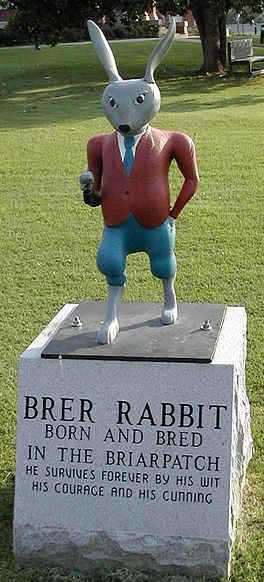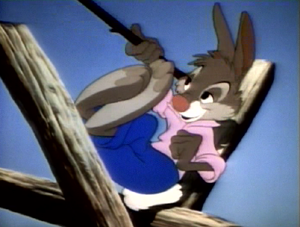Br’er Rabbit
(also spelled Bre’r Rabbit or Brer Rabbit or Bruh Rabbit) is a central figure
in the Uncle Remus stories of the Southern United States. He is a trickster
character who succeeds through his wits rather than through strength, tweaking
authority figures and bending social mores as he sees fit.
Although Joel
Chandler Harris collected materials for his famous series of books featuring the
character Br’er Rabbit in the 1870s, the Br’er Rabbit cycle had been
recorded earlier among the Cherokees. The “tar baby” story was printed in an
1845 edition of the Cherokee Advocate three years before Joel Chandler Harris
was born.
Rabbit/Hare
myths abound among Algonkin Indians in Eastern North America, particularly under
the name Manabožo ‘Great Hare’, who is generally regarded as supreme deity
among tribes in eastern Canada. “It appears that Joel Chandler Harris, when he
wrote them, did not realize that his Br’er Rabbit and Br’er Fox were
originally Cherokee inventions.” (“The Cambridge History of American
Literature, Later National Literature”)
In the Cherokee
tale of the Briar Patch, “the fox and the wolf throw the trickster rabbit into
a thicket from which the rabbit quickly escapes”.
There was a
“melding of the Cherokee rabbit-trickster ... into the culture of African
slaves.” (That the People Might Live: Native American Literatures and Native
American Community) “In fact, most of the Br’er Rabbit stories originated in
Cherokee myths.”
The stories can
also be traced back to trickster figures in Africa, particularly the hare that
figures prominently in the storytelling traditions in Western, Central and
Southern Africa. These tales continue to be part of the traditional folklore of
numerous peoples throughout those regions. In the Akan traditions of West
Africa, the trickster is usually the spider (Anansi), though the plots of spider
tales are often identical to those of rabbit stories.
Many have
suggested that the American incarnation, Br’er Rabbit, represents the enslaved
African who uses his wits to overcome circumstances and to exact revenge on his
adversaries, representing the white slave-owners. Though not always successful,
his efforts made him a folk hero. However, the trickster is a multi-dimensional
character. While he can be a hero, his amoral nature and lack of any positive
restraint can make him a villain as well. For both Africans and African
Americans, the animal trickster represents an extreme form of behavior which
people may be forced to emulate in extreme circumstances in order to survive.
The trickster is not to be admired in every situation; he is an example of what
to do, but also an example of what not to do. The trickster’s behavior can be
summed up in the common African proverb: “It’s trouble that makes the monkey
chew on hot peppers.” In other words, sometimes people must use extreme
measures in extreme circumstances.

Statue
of Br’er Rabbit in
Eatonton, Georgia
The American
version of the story is said to have originated among slaves at Laura Plantation
in Vacherie, Louisiana. Br’er Rabbit stories were written down by Robert
Roosevelt, uncle of President of the United States Theodore Roosevelt. Teddy
Roosevelt wrote in his autobiography, about his aunt from Georgia, that “She
knew all the ‘Br’er Rabbit’ stories, and I was brought up on them. One of
my uncles, Robert Roosevelt, was much struck with them, and took them down from
her dictation, publishing them in Harper’s, where they fell flat. This was a
good many years before a genius arose who, in ‘Uncle Remus’, made the
stories immortal.”
